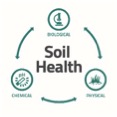This item has been supplied by a forage marketer and has not been edited, verified or endorsed by Hay & Forage Grower.
AgSource Laboratories is excited to introduce the Soil Health Assessment. This new soil report combines the chemical and physical results of traditional soil testing with biological assessments of microbial activity to provide a measure of the quality of the soil. In general, a higher score means a more healthy soil, and improving the score over time indicates that management practices are benefiting the soil and improving soil health.


Improving soil health is a long term process that will build up the ability of the soil to sustain crops from season to season and year to year. Increasing organic matter improves structure and nutrient cycling because of greater microbial activity. Improved structure helps to retain plant available water for longer periods between rains. Both of these will benefit crops by mitigating against variability of water and nutrient supply during the growing season. That could impact profits through reduced fertilizer inputs or better growth during hot summer weather.
“Healthy soil has more organic matter, greater pore space and better water holding capacity,” notes Dr. Friedericks. “Nutrient cycling of nitrogen, phosphorus and micronutrients is improved as well.”

The cover crop recommendations in the report are formulated to meet two objectives: to provide the soil with easily decomposable plant biomass for better health and to retain the nutrients that are still present in the soil after crop harvest. In addition to planting cover crops, other management practices that can help improve soil health include reducing tillage, extending rotations and diversifying your cover crop mixture.
How to Sample
· Normal soil sampling guidelines apply: take the sample at 6-8 inch depth; combine multiple cores to make a representative sample; and zone sampling can also be used for soil health.
· Sample size is similar to fertility testing, around 2 cups. Fill a bag and mail as soon as possible. Samples will be dried in the lab when received.
AgSource is a leader in agricultural, turf and environmental laboratory analysis and information management services, with facilities in Iowa, Nebraska, Oregon and Wisconsin. A division of Cooperative Resources International, AgSource Laboratories provides testing services to clients in the United States and across the globe. Learn more at www.AgSource.com.

